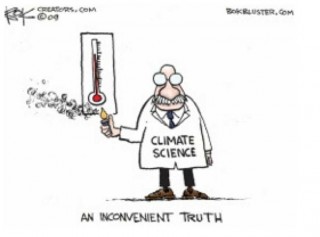By Kevin Barrett, VT Editor
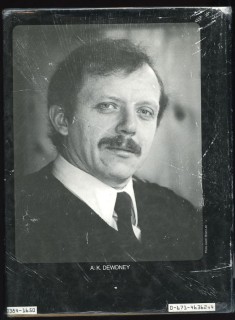
[Listen to AK Dewdney come out as a climate change skeptic on Truth Jihad Radio]
The Intergovernmental Panel on Climate Change (IPCC) claims to speak for a consensus of climate scientists. The latest IPCC report paints a dire picture of “the chaos of runaway climate change” and calls for drastic cuts in fossil fuel consumption.
When I turn on National Public Radio – I won’t call it National Socialist Public Radio because that would be unfair to the National Socialists – I hear the same mellifluously mendacious voices lobbing almost identical ad hominem insults at “conspiracy theorists” and “global warming deniers.”
It’s barely-disguised, carefully-scripted propaganda designed to short-circuit rational thought. Whenever they rely on ad hominems, you can bet that they don’t have much in the way of real arguments.
The “conspiracy theories,” of course, are true. So maybe the “deniers” are right as well?
I’m not qualified to judge the scientific evidence in the climate change debate. But I’m suspicious of people who argue by vilifying their opponents. And I have noticed that plenty of smart, honest, qualified scientists don’t buy the IPCC “consensus.”
One of them is University of Western Ontario professor AK Dewdney, founder of Scientific Professionals Investigating 9/11, who just came out this evening as a “climate change denier” (ahem). In an exclusive interview with Truth Jihad Radio, Dewdney derided the alleged IPCC consensus and spoke in favor of the alternative theory associated with the research of Henrik Svensmark. Below is Professor Dewdney’s draft of an article on the subject, which he kindly has allowed me to publish here.
-KB
The Influence of the Solar Magnetic Field on Earth’s Climate
[draft]
A K Dewdney November 14 2014
Introduction
Last winter eastern North America and parts of western Europe experienced unusual cold, a phenomenon which, in the eyes of many, seemed to fly in the face of claims for global warming. Until nearly the end of the 20th Century global temperatures had increased by about 0.6o C, overall, with a period of cooling in the 1960s and early 70s, followed by continuing warming. However temperatures began to level off just before the year 2000 holding a steady, on average, since then. Then came the Northern Hemisphere winter of 2013-14.
As far as the levelling off of temperatures is concerned, the change in terminology urged on us by the Intergovernmental Panel on Climate Change (IPCC) from “global warming” to “climate change” may amount to an implicit admission of this reality. Unfortunately the latter terminology tends to conflict with its traditional meaning as applied to long-term (non-anthropogenic) changes in global tempera- tures and this article will use that meaning exclusively. As used by the IPCC the term is essentially content-free since any extreme weather event can be slotted in as evidence of “climate change.” Over time the Earth has always experienced “extreme weather events” and undoubtedly alway will.
The unusually cold weather, apparently to be followed by more in 2014-15, has another explanation altogether. A new theory of climate change rooted in solar magnetic behaviour has been steadily gaining ground among climatologists in spite of what amounts to a media blackout on this development. Henrik Svensmark is a solar physicist who, along with a large team of other researchers has developed a whole new theory of climate that appears to explain not only past ice ages, but applies to “normal” times as well.
In a nutshell, here is how the Svensmark theory works: The solar system is, at all times and from all directions, being bathed in a continuing shower of extremely energetic particles called cosmic rays. These result from the explosions of distant stars into novae and supernovae, an ongoing process which, owing to the very large number of such explosions, produces a constant shower. The terminology “cosmic ray” is something of a misnomer that dates back to the earliest research in this area. A particle is a “ray” that has undergone wave-function collapse, a central phenomenon of quantum mechanics.
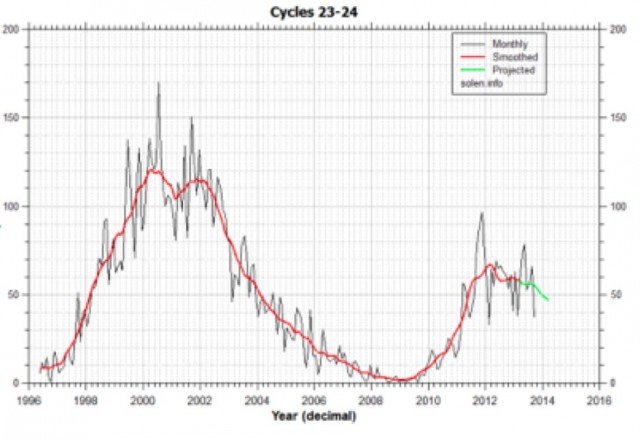
The particles in question have two important properties. First, they are energetic enough to penetrate the Earth’s protective Van Allen belts as if they were not even there. Secondly, they are normally deflected by the sun’s powerful magnetic field, a deflection zone that shields all four inner planets. Should that field fail, even partially, the cosmic ray shower increases in intensity here on Earth. Enter the 11- year solar cycle: Every 11 years the sun’s magnetic field undergoes a pole reversal event during which the field’s orientation reverses: magnetic “north” and magnetic “south” exchange positions. During this process, solar magnetic field intensity declines to zero, then increases back to its “normal” strength. In the summer of 2013, as the sun entered the end of its usual 11-year solar cycle, the magnetic field began to weaken, but never recovered its former strength, as shown in Figure 1. Since the weakening began, the Earth has been exposed to a much higher flux of cosmic rays. The basic causal chain works like this:
higher cosmic ray => more cloud formation => lower global temperatures 2
Cloud formation
Svensmark is a solar physicist with solid credentials and a publishing history that includes the discovery of a near-perfect correlation of nearby supernovae explo- sions with past ice ages. (See References.) Somehow, the radiation resulting from these explosions caused extensive cloud formation on the earth, cooling the planet under a heavy blanket of cloud, causing mass extinctions and the growth of vast ice sheets. The resulting periods of cold are called “ice ages” and are well- documen- ted by paleogeographers, both as to duration and extent.
A puzzle that has long eluded those who study meteorology is the process of cloud formation right here on Earth. We have known for the better part of the 20th Century that water molecules congregate around atmospheric dust particles, but there has never been a compelling explanation for the exact mechanism of the attraction and resulting adhesion and accumulation of molecules to the point where a water droplet becomes visible (Cole 1980). It was thought for a long time that atmospheric molecules of sulphuric acid play an intermediary role, but that hypothesis had to be abandoned in 1996. In that year extensive research into cloud formation conducted over the Pacific ocean in 1996 by a team led by Tom Clarke of the U of Hawaii proved otherwise (McNeil et al, 1998).
The primary mechanism of cloud formation did not occur to anyone until Svens- mark, simply by chance, attended a physics seminar about an unrelated topic. In the course of the lecture, the speaker reminded his audience of early use of the Wilson cloud chamber and how alpha- and other particles produce thin lines of condensation as they travel through the chamber. Although such cloud chambers use methanol vapour to demonstrate the track of a particle, the same principle, thought Svensmark, might apply to a humid atmosphere of water vapour under the right conditions. Subsequent experiments conducted by Svensmark and a team of researchers demonstrated for the first time the production of a condensation process in humid air by charged particles, as described in the next paragraph. Meanwhile scientists at CERN, the European physics facility in Geneva, had become interested in the potential link between cosmic ray flux and cloud formation. A team of some 50 scientists from around the world met to discuss the proposal. After much resistance and foot-dragging by various officials and skeptical scientists, the project had more hurdles to leap before a suitable reaction chamber could be built. It was not until 2010 that the first experiments at CERN went forward.
Meanwhile, frustrated by the long delays, Svensmark and his team assembled funding to build an experimental reaction chamber at the Danish National Space Center. They began experiments in 2005 and finished later that year. The results surprised everyone. A single particle could catalyse more than one molecular assembly on the way to droplet formation. This not only meant that the process was very efficient, but led to a new theoretical model that matched experimental results very closely (Svensmark & Calder, 2008).
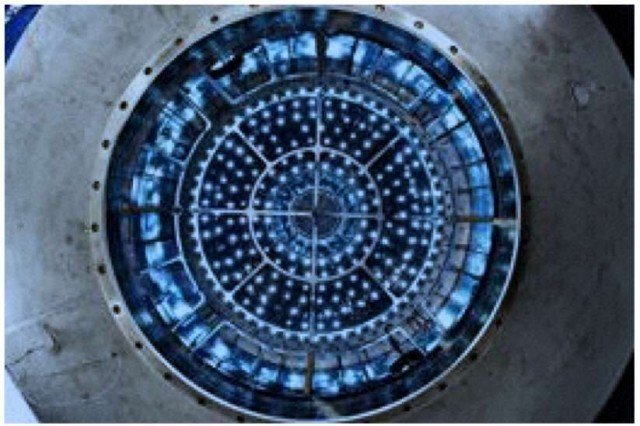
The results of the CERN experiments confirmed the role of radiation in the process of cloud formation. The wait had been long, partly because CERN was involved in a massive Hadron-collider project, other experiments having been placed on hold. When the experiment called CLOUD finally got under way, it soon became evident that, insofar as the particles produced by the accelerator at CERN imitated cosmic rays, the formation of the aerosols essential to cloud production was indeed greatly enhanced by the particles (CERN 2011).
The North American Winter of 2013/14
People living in North America can be forgiven for questioning global warming in the face of a severe winter that broke many records for low temperature and the extent of snowfall. Those living in the eastern half of North America took the brunt of this unusual weather, while those in the western half had a relatively normal winter. How does one explain this seeming anomaly?
All cloud formation must begin with the presence of sufficient water vapour in the atmosphere. The higher the humidity, the more water vapour the atmosphere must contain. No humidity in a given area means that no clouds are likely to form there. Even high humidity cannot guarantee cloud formation without a catalysing effect. Among the various effects that may exist, the Svensmark mechanism appears to be a key player. We may therefore emend the causal chain displayed above as follows:
higher radiation + humidity => more cloud => lower global temperatures
The map of average humidity in the United States that appears in Figure 3 provides a simple explanation of the anomalous winter of 2013-14. On average, the eastern half of the continent is generally more humid than the western half. Moreover the trade winds carry warm moist air from the Gulf of Mexico northeastward (Cole 1980), the same general track followed by a seemingly endless conveyer belt of storms in 2013-14.
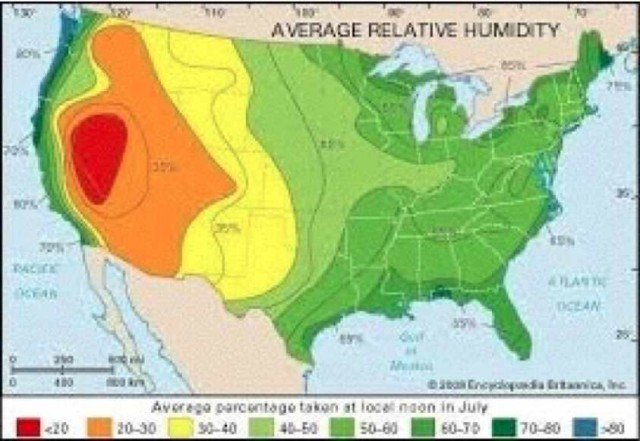
Another manifestation of solar-induced climate change is increased rainfall. Besides cooling the Earth and producing snow, this form of climate change also produces higher precipitation in general; the more cloud formation occurs, the more likely such clouds are to produce rain, other things being equal.
The Little Ice Age
This brings us to a little-known but rather profound change of climate known as The Little Ice Age (Fagan 2002). It began in 1315 AD and lasted, off and on, until the mid 19th century. The colder, rainier climate was interspersed with nearly normal periods. But in more than one epoch heavy continuous rains or continuous cold throughout Europe meant that crops could neither be planted nor harvested for several years in a row. The result was mass famine, with about a quarter of France’s population actually dying of starvation. Similar statistics prevailed in England, Holland and other European countries during such periods. The Viking settlements in North America had to be abandoned and colonists and natives alike in North America also suffered famines. Moreover, glaciers in mountainous and polar regions began to grow again, even as temperate forests began to succeed back from hardwoods to coniferous stands.
In a parallel development, sunspots were almost unknown during the Little Ice Age. Although regular observation of sunspots did not begin until the time of Galileo, they had been observed, off and on, for many centuries before him. However, he observed them only rarely and was somewhat puzzled by such blemishes on this otherwise perfect orb. The point is that even though the sun was coming under increased scrutiny, sunspots were rather rare over the following centuries, with a few interruptions of sunspot activity. During the latter half of the 19th Century sunspots began to appear with more regularity, even as the climate began to warm up to levels typical of the 20th Century.
Sunspots may be taken as indicators of solar magnetic field strength. The stronger the field, the more turbulent and disorganized the internal lines of force become, forming vortices that erupt on the suns’s surface as solar flares and sunspots.
Prediction of another severe winter for 2014-15
Based on the apparent validity of the Svensmark theory, long-range weather prediction becomes somewhat simpler, at least in broad outlines; as long as the solar magnetic field remains weak, one may expect increased precipitation and lower temperatures in the most humid areas of the Earth. Since it was still weak when I last looked, I expect another severe winter ahead as we pass through the autumn season in North America. Beyond this, it would be foolish to press the issue and predict greater or lesser severity.
Amusingly, the venerable Farmer’s Almanac also predicts a hard winter ahead, it’s editor, Jack Burnett stating, “We’re looking at the T-Rex of winters.” The more conventional AccuWeather forecasters, however, predict a warmer than average autumn over the same area and that cold weather won’t arrive until February, along with snow. It will be interesting to see how these opposite views play out over the coming months.
Whither the Intergovernmental Panel on Climate Change?
A special United Nations body called the Intergovernmental Panel on Climate Change (IPCC) has been the main source of authoritative pronouncements on “global warming”. The name was changed to “climate change”, probably because the IPCC realized that temperatures had started to level off around 1998 and into the new millennium. In the new context, the change of label made it easier to create the kind of concern needed to keep the initiative alive. People would gradually forget that things are supposed to get warmer. They would also likely forget the hundreds of extreme weather events they had witnessed over their lifetimes. A new emphasis on extreme weather events by the media would play into the “climate change” scenario, seemingly reinforcing it. I have never seen any explanation of how increased CO2 could possibly result in extreme weather events without an accompanying increase in global temperatures.
Statements from the IPCC continue not only to warn us about “climate change” but cite a “consensus” of scientists that back the warnings. We also hear that “the science is settled”. It turns out that both statements are questionable. Claims of a consensus are not only exaggerated, but completely wrong. We have compiled a list of several hundred meteorologists and climatologists who have publicly stated their disagreement with either “global warming” or the newly minted “climate change” scenario. Among these many names and statements we have found a local climate expert and veteran weather modeller, Dr Christopher Essex at Western University in London, Ontario. Essex (2009) has been at pains to point out not only the questionable science behind global warming, but an ongoing virtual smear campaign against scientists who dare to disagree with its conclusions. Grants are lost, papers are turned down for publication, sometimes even jobs vanish. Rhetoric replaces reasoned discussion as the shutout continues. A search of other sources has amply confirmed these allegations. (See also Ball 2014.) The campaign, as such, bears an an eerie resemblance to Orwell’s 1984.
As for the science being settled, Essex is particularly critical of the long-range climate models that have been used to bolster IPCC claims: the models make different predictions owing to different underlying designs. Invariably, however, the models include parameters the input values of which determine overall beha- viour. One such parameter is global CO2 concentration, another is the amount of heat reflected back to the Earth. The point is that parameters may be tweaked (readjusted) until they give the desired outcome, a runaway warming trend (Ball 2014). Indeed, statisticians have discovered evidence of fraud in the work of scientists at East Anglia University in the UK, charging them with exaggerating recent temperatures while reducing those in the past. The hockey-stick model of global temperature increases had proved to be fallacious at best and deliberately fraudulent at worst. (Booker 2009) One example that illustrates this chicanery is the use of data (ring width in cores) from Bristlecone Pines in a highly selective manner that would produce the infamous hockey-stick shape and ignoring other Bristlecone data that would tame the “hockey stick” to a temporary perturbation. (McIntyre 2012) Indeed, a scandal developed over the discovery of several thousand emails between members of the East Anglia research team in 2008. In many of these messages, advice to doctor the figures was passed along. The result was a brief flurry of media attention that soon dried up, but left many people skeptical. The story lives on in the Internet.
The role of print and broadcast media in all of this seems undeniably one-sided. The idea of a scientific consensus continues to dominate stories on climate change, along with occasional remarks that compare dissenters to holocaust “deniers” or even “terrorists”. Occasional op-ed pieces in print media have expressed skepti- cism about the warming scenario, but these tend to drown in a sea of broadcast claims. Meanwhile, the Svensmark theory of (real) climate change is clearly non- anthropogenic and so gets no media attention.
What has happened to the print and broadcast media? While some news and comment websites, even usually well-informed ones, claim a “controlled” mainstream media, our explanation is simpler. Think of a gigantic, very heavy flywheel that, once set in motion, becomes increasingly harder to stop. A spin, if you like, that can hardly stop over-night. Initial presentations of the new theory of climate change would be met by a storm of protest from believers in anthropogenic climate change. Should brave media types persist, however, the tide will undoubt- edly turn as people realize that global warming simply isn’t happening the way the IPCC predicted that it would. Moreover, the very opposite might well be happen- ing and there is an adequate, well-researched explanation for the difference.
Some critics of the anthropogenic climate change scenario point out what they believe to be the main reason for the IPCC campaign: public concern would pave the way for a new multinational carbon tax to be levied by the International Monetary Fund (IMF), a (privately owned) central bank for the world. The idea behind the carbon tax is to punish those countries that do not take appropriate steps to curb hydrocarbon emissions, a step that believers heartily endorse, even as they try to use personal vehicles less and take other steps to reduce their own “carbon footprint”. Mean-while the owners of the IMF would levy fines running into the trillions. How did the IMF get into this position and who gave it such taxation powers? It is not generally realized that the IMF is far more than a central bank. Its political reach beggars the imagination (Perkins 2000).
Disintegration of the Social Consensus
Human beings react predictably in certain social situations. If someone has a long- held belief in a certain story, he or she naturally becomes upset at the merest sug- gestion that the story is not true. The reaction is likely to be much stronger if there is a personal investment in the story. In such cases anger boils to the surface, along with an immediate expression of denial that usually takes a rhetorical form; “Everyone knows that it’s true,” (appeal to consensus) or “You must be nuts”! (shooting the messenger) or walking away in apparent disgust (flight). In the present case, such persons would include members of the media, members of any “green” activist group, a scientist with research (funding) tied to global warming, numerous government officials, and so on.
When your world threatens to fall apart, you move instinctively to use any means at hand to shore up your belief system. The more hardened your position becomes, the more difficult it is to reconsider later on. The only thing that helps people who get themselves into this predicament is the discovery that a great many compeers or colleagues no longer believe the story. One may then chime in with, “I must say, I had my doubts.” The broader suspicion that the media is misinforming the public is unsettling to virtually everyone. “How could the public institutions on which we rely so heavily mislead us in this fashion!” The question is asked both rhetorically and sincerely.
Meanwhile, the Earth has other problems besides climate change: habitat des- truction, pollution of air, water and land, loss of consultative governance, and overpopulation to name just a few. By all means, use your vehicle less, learn to live more simply, encourage others to appreciate nature and, finally, prepare for a possible shift in climate to include what some now call “cosmic ray winters.”
Note on Henrik Svensmark: Currently head of the Center for Sun-climate Research at the Danish National Space Center, Svensmark has previously held positions at the University of California at Berkeley, the Nordic Institute of Thgeoretical Physics, the Niels Bohr Institute and the Danish Meteorological Institute. He has published over 50 scientific papers, including nine landmark papers on climate physics. He received the Knud Hojgaard Anniversary Research Prize in 1997 and the Energy-E2 Research Prize in 2001.
About the Author: Kee (A. K.) Dewdney is a mathematician and scientist who held positions in Computer Science (Associate Professor) at his home institution of Western University in London ON and at the University of Waterloo (Full Professor) before retiring in 1995. He became Adjunct Professor in Western’s Biology Department where he worked in theoretical population biology. Dewdney also wrote for Scientific American Magazine from 1984 to 1990. He has published 13 science books, including two on bad science. (See references.)
References: (print and internet sources)
Ball, Tim (2014). The Deliberate Corruption of Climate Science. Stairway Press, Seattle WA.
Booker, Christopher (2009). “Climate change: the worst scientific scandal of our generation”. The Telegraph, Nov. 28, 2009. <http://www.telegraph.co.uk/comment/ columnists/christopherbooker/6679082/Climate-change-this-is-the-worst- scientific-scandal-of-our-generation.html>
CERN (2011). CERN’s CLOUD experiment provides unprecedented insight into cloud formation. CERN Press Release No.15, 2011.
Cole, Franklyn W. (1980). Introduction to Meteorology. Third Ed. John Wiley & Sons, New York NY.
Dakota, C. B. (2014). Climate Change Sanity <https://cbdakota.wordpress.com/ category/sunspots/page/2/>
Dewdney, A. K. (1993). 200 Percent of Nothing: An Eye-Opening Tour Through the Twists and Turns of Math Abuse and Innumeracy. John Wiley & Sons, New York NY.
Dewdney, A. K. (1997). Yes We have no Neutrons: An Eye-Opening Tour Through the Twists and Turns of Bad Science. John Wiley & Sons, New York NY.
Christopher Essex and Ross McKitrick (2009). Taken by Storm: The Troubled Science, Policy and Politics of Global Warming. Key Porter Books, Toronto ON.
Fagan, Brian. (2002). The Little Ice Age: How Climate Made History 1300 – 1850. Basic Books, New York.
McIntyre, Steven (2012). Yalal FOI Sheds New Light on Flawed Data. Climate Audit: <http://climateaudit.org/2012/05/06/yamal-foi-sheds-new-light-on-flawed- data/>
McNeil, R. J. et al. (1998). The NASA Global Tropospheric Experiment, IGACtivities Newsletter, No. 13, March ’98.
Perkins, John (2004). Confessions of an Economic Hit Man. Plume/Penguin, New York.
Henrik Svensmark & Nigel Calder (2008). The Chilling Stars: A Cosmic View of Climate Change. Totem Books/Penguin.
Svensmark, Henrik (1998). “Influence of cosmic rays on Earth’s Climate.” Physical Review Letters, 81 (22): 5027-5030.
Svensmark, Henrik (2007). “Cosmoclimatology: a new theory emerges.” Astro- nomy & Geophysics (Blackwell Publishing) 48 (1): 18-24
Henrik Svensmark, Jens Olaf P. Pedersen, Nigel D. Marsh, Martin B. Enghoff & Ulrik I. Uggerhøj (2007). “Experimental evidence for the role of ions in particle nucleation under atmospheric conditions” (pdf). Proceedings of the Royal Society A: Physical and Engineering Sciences, 463 (2078): 385-396.
Henrik Svensmark, Torsten Bondo and Jacob Svensmark (2009). “Cosmic Ray Decreases Affect Atmospheric Aerosols and Clouds.” (pdf). Geophysical Research Letters, 36: L1501.
M. B. Enghoff, J. O. Pepke Pedersen, U. I. Uggerhøj, S. M. Paling and H. Svens- mark (2011). “Aerosol nucleation induced by a high energy particle beam.” (pdf) Geophysical Research Letters, 38: L09805.
Additional Web References:
This article in Nature on 2011 was the first to appear in a leading science publication:
http://www.nature.com/news/2011/110824/full/news.2011.504.html>
Article in Forbes Website: “Sun Flatlining According to Solar Physicist”:
Article in Forbes Website: “As Global Warming Narrative Unwinds IPCC in Damage Control Mode”:
IceAgeNow.Info: Real Risk of a Little Ice Age, says Leading Scientist: http://iceagenow.info/2013/10/real-risk-ice-age-leading-scientist/
Speakers Profile of Christopher Essex at ICSC Meeting: http://
climatescienceinternational.org/index.php
Global Research: “Global Cooling is Here”: http://www.globalresearch.ca/global-cooling-is-here/10783
WattsUpWithThat: “More Support for Svensmark’s Cosmic Ray . . . Hypothesis”:
http://wattsupwiththat.com/tag/henrik-svensmark/
Meteorologist John Coleman, co-founder of the Weather Channel: ”Climate Changed Proved to be Nothing but a Lie”: http://patriotrising.com/2014/10/22/climate-change-proved-nothing-lie-claims-top-meteorologist/
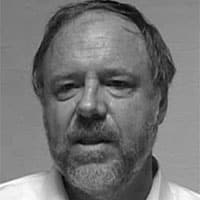
Dr. Kevin Barrett, a Ph.D. Arabist-Islamologist is one of America’s best-known critics of the War on Terror.
He is the host of TRUTH JIHAD RADIO; a hard driving weekly radio show funded by listener donations at Patreon.com and FALSE FLAG WEEKLY NEWS (FFWN); an audio-video show produced by Tony Hall, Allan Reese, and Kevin himself. FFWN is funded through FundRazr.
He also has appeared many times on Fox, CNN, PBS, and other broadcast outlets, and has inspired feature stories and op-eds in the New York Times, the Christian Science Monitor, the Chicago Tribune, and other leading publications.
Dr. Barrett has taught at colleges and universities in San Francisco, Paris, and Wisconsin; where he ran for Congress in 2008. He currently works as a nonprofit organizer, author, and talk radio host.
ATTENTION READERS
We See The World From All Sides and Want YOU To Be Fully InformedIn fact, intentional disinformation is a disgraceful scourge in media today. So to assuage any possible errant incorrect information posted herein, we strongly encourage you to seek corroboration from other non-VT sources before forming an educated opinion.
About VT - Policies & Disclosures - Comment Policy

